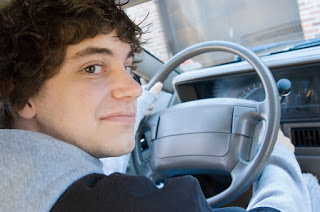Category Archive: Driving Skills

Teens and Nighttime Single Vehicle Crashes
November 16, 2009
As you read the daily news, a familiar pattern begins to occur. You begin to notice the car crashes that happen at night with only one vehicle involved. Many times, these crashes involve teen drivers.
Is it your imagination? No.
Many typical characteristics of teen crashes are:
- Teens are more likely than any other age group to be involved in a single vehicle crash. Among passenger vehicle drivers’ ages 16-19 involved in fatal crashes in 2008, 49 percent were involved in single-vehicle crashes. (Insurance Institute for Highway Safety)
- Nighttime fatal crash rates for 16 year olds are nearly twice as high as daytime rates. Centers for Disease Control and Prevention (CDC)
- In 2008, 37 percent of the 15- to 20-year-old male drivers who were involved in fatal crashes were speeding at the time of the crash.
Nighttime driving not only diminishes a driver’s visibility, but also their distance and speed perception, making it harder to judge a situation and respond quickly. Speeding decreases the time and space available to react and increases the severity of any injuries. Many times teenagers react too quickly and overcorrect or lose control of the vehicle, resulting in a single-vehicle crash. Drowsy driving is also more prevalent at night, and teens are especially vulnerable to fatigue and need additional sleep during this developmental time. In addition, other drivers on the road are more likely to be less attentive, drowsy or under the influence at night.
What can be done?
Create and enforce stricter Graduated Drivers Licensing (GDL) laws that give teens the privilege of driving but limit their exposure to higher risk situations encountered, by restricting nighttime driving, teen passengers and cell phone use. Experience behind the wheel is best gained in the daytime when accompanied by an experienced adult driver and under ideal driving conditions. GDL has proved successful in reducing crashes and fatalities among teen drivers as they progress to unrestricted driving at age 18.
Teens are ready to drive and need to be given the tools to drive safely. Understand the risk factors that young teen drivers face and place limits on driving privileges until they acquire the valuable experience needed to develop those tools safely.

Teens and Drowsy Driving
October 29, 2009
Does the morning alarm seem to come too early in the day? Do you catch yourself daydreaming or having trouble focusing throughout the day? Do you find yourself rubbing your eyes or yawning? You may be suffering from Sleep Deprivation.
Being sleep deprived has a cumulative effect. The National Sleep Foundation (NSF) recommends 8.5 to 9.5 hours of sleep for teens to be fully rested and notes that other professionals recommend higher amounts. The less sleep you have, the more deprived you are and it continues to add up during the week.
Reduced amounts of rest affect judgment, performance, information processing, emotions, and reaction time. All factors which are heavily relied upon for everyday functions and especially important when operating a vehicle. The National Highway Safety Transportation Association (NHSTA) estimates falling asleep at the wheel is responsible for at least 100,000 automobile crashes, 40,000 injuries, and 1,550 fatalities nationwide per year. They have identified young people as a high risk population for drowsy driving.
Teens typically have full schedules, academic and social pressures to balance. Their body clocks change during this developmental time, calling for them to stay up later at night and wanting to sleep in longer in the morning. When teens drive without sufficient amounts of sleep, they are even more vulnerable to the dangers teen drivers already face including:
- Distracted driving due to cell phones, texting, other passengers, adjusting music and eating or drinking
- Inexperience
- Impulsive behavior, including reckless driving, tailgating and speeding
- Lack of consistent seat belt use
- Reduced visibility at dawn, dusk or night
Other risks that increase drowsiness include:
- Colds, viruses and the flu
- Many prescription and over the counter medications
- Sleep apnea
- Alcohol consumption
NHSTA has identified late night, late afternoon and morning hours between six and eight a.m. as the hours teens are most tired and in the most jeopardy. Getting enough rest and avoiding high risk behaviors at specific times help to prevent drowsy driving. Also consider asking a passenger to stay alert and share the driving responsibility.
How can you over come driving drowsy? The National Sleep Foundation has the following suggestions:
- Watch for the warning signs of fatigue
- Stop driving-pull off at the next exit, rest area or find a place to sleep for the night
- Take a nap-find a safe place to take a 15 to 20-minute nap
- Consume caffeine-the equivalent of 2 cups of coffee can increase alertness for several hours
- Try consuming caffeine before taking a short
Be safe and get some rest.
Learn more at the National Sleep Foundation (NSF). The NSF has established November 2-8 as Drowsy Driving Prevention Week.

Teens and Motor Vehicle Crashes
August 28, 2009
The tragedy occurred on the last day before summer vacation. An SUV transporting a group of teens to the beach rolled over after a tire blowout. In the aftermath, four teens died, four were hospitalized, and the teen driver faced criminal charges.
Almost everyone knows a distressing story like this one; deaths of teens due to motor vehicle crashes are often well-publicized amid great community sympathy for the loss of young lives and the potential they held, as well as the devastation of surviving parents and friends. And they speak to a larger statistical reality – that motor vehicle crashes are the leading cause of death for 15- to 20-year-olds, according to the National Center for Health Statistics – that much of America seems to be both aware of, but unsure of how to change.
Consider the following statistics from the National Highway Traffic Safety Administration (NHTSA):
- There were 202.8 million licensed drivers in the United States in 2006 (2007 data not available). Young drivers between 15 and 20 years old accounted for 6.4 percent (13.0 million) of the total, a 7.2-percent increase from the 12.1 million young drivers in 1996.
- In 2007, 13 percent (6,982) of all drivers involved in fatal crashes (55,681) were young drivers age 15 to 20 years old, and 15 percent (1,631,000) of all drivers involved in police-reported crashes (10,524,000) were young drivers.
- In 2007, 3,174 15- to 20-year-old drivers were killed and an additional 252,000 were injured in motor vehicle crashes.
- Among 15- to 20-year-old drivers involved in fatal crashes in 2007, 31 percent of the drivers who were killed had been drinking.
- In 2007, 64 percent of the young drivers of passenger vehicles involved in fatal crashes who had been drinking were unrestrained. Of the young drivers who had been drinking and were killed in crashes, 75 percent were unrestrained. -During 2007, 35 percent of the motorcycle riders between 15 and 20 years old who were fatally injured in crashes were not wearing helmets.
In addition to mistakes made while driving, teens are susceptible to other lapses in judgment concerning motor vehicles that can lead to injury or death, such as car surfing. According to Science Daily, the states with the highest car-surfing fatality rates are California, Florida, and Texas; all three states have shown an increase in car-surfing deaths since 2000.
Though these three states show high levels of risky teen behavior concerning motor vehicles, a study conducted by Allstate Insurance Company indicated that rural areas have much higher rates of fatal motor vehicle crashes involving teen drivers than metropolitan areas; consequently, states with large rural areas have the highest rates of fatal crashes involving teen drivers. These states are:
- Mississippi
- Alabama
- Kentucky
- Missouri
- Arkansas
Nationally, Allstate’s research showed, fatal crash rates for teens were more than twice as high in rural areas than in metropolitan areas.
While considerable attention is paid to the issue of drunk driving among teens, law enforcement agencies report that speeding is the leading cause of motor vehicle crashes involving teen drivers. Allstate’s study found that law enforcement identified speeding as a factor in 34% of motor crashes nationwide, while alcohol was cited in just 12% of crashes.
In addition to the risk teens take when driving or when riding in a vehicle with other teens, teens suffer when a member of their peer group dies in a motor vehicle crash, particularly when they suffer multiple losses from crashes such as the example at the beginning of this article. Because of the feeling of invincibility that is characteristic of this age group, teens typically have not considered the deaths of people their age a possibility, so when such a thing occurs, their world may seem to be crashing down around them. This means that even teens who were not particularly close to the person who died can be stunned by their reaction to it. Due to their level of psychological maturity, teens are ill-equipped to understand the grieving process and may be overwhelmed by feelings of being out-of-control, insecure, and scared, in addition to sorrow and grief. They may descend into melancholy that lasts years, greatly affecting their development. Some teens numb their feelings by participating in high-risk activities such as:
- Alcohol and drug abuse
- Reckless sexual activity
- Withdrawal from family and friends
- Taking risks involving motor vehicles
Depending on the loss, some teens experience a change in their circle of friends. Obviously, this can have positive or negative results, but regardless, it is another change in a rapidly changing world for the teen. Teens who lose friends to death may see their grades drop and their focus change as they struggle to fit into a new group of friends at a time when they feel especially vulnerable.
Parents and other authority figures can help teens channel their grief in healthier ways by:
- Being available to listen – not, necessarily, to talk
- Allowing teens the freedom to process their grief with others, such as friends, extended family, and professional counselors
- Encouraging teens to express themselves through writing, drawing, and memorializing their deceased friends
- Realizing that the teens’ mourning process may be prolonged and letting teens know that there is no timetable for grief
Though the federal government, state governments, and community-based organizations are making efforts to reduce the number of teens who die in motor vehicle crashes, the statistics above indicate that there is still much work to be done. Forty-six states and the District of Columbia have three-stage Graduated Driver Licensing (GDL) programs in which restricted licenses are issued to beginning teen drivers, with the restrictions reduced over time. However, no state has incorporated all of the GDL components recommended by the Insurance Institute for Highway Safety, the National Transportation Safety Board, and NHTSA.
State-level programs that include peer-to-peer teaching and learning about driver safety are effective in reducing teen motor vehicle crash rates. Texas’ Teens in the Driver Seat is one such program; teen crash deaths have dropped 32% and the number of teen drivers involved in fatal motor vehicle crashes is down 33% since the program began. A similar program in Illinois called Operation Teen Safe Driving has helped achieve a 10% reduction in teen motor vehicle fatalities in Illinois during the first seven months of 2009. Mothers Against Drunk Driving (MADD), Students Against Destructive Decisions (SADD) and other advocacy groups sponsor many public education campaigns to persuade teens not to drive under the influence of alcohol or drugs.

How Teens Can Drive Safely on the Expressway
June 9, 2009
A complete driver-training program includes lessons on all types of streets and highways, both night and day, in a variety of weather and traffic conditions. But many teens get the majority, if not all, of their driver training on familiar roads close to home. Some young drivers do not make their first expressway trip until after they are licensed and driving on their own. This is a high-risk method for teens to gain driving experience, because:
- Young drivers who don’t have freeway experience have trouble controlling vehicles traveling at high speeds
- Teens have minimal experience in dealing with emergency driving situations, particularly at high speeds
- When expressways are unfamiliar to drivers, they spend more time searching the driving scene for directional signs and landmarks
- Teens often aren’t aware of the level of risk on interstates, so they may continue other risky driving behaviors, such as non-use of seat belts and allowing distractions such as loud music and noisy passengers
- Though expressways have a low incidence of collisions, the crashes that do occur have high injury severity rates because the higher speeds exponentially increase the amount of force involved in the crash
Commentary driving is an excellent way to train teens to drive safely on the expressway. With commentary driving, teens maintain a running dialogue of their progress – what they notice as they observe the roadway and what actions they will take: “The car in front of me is slowing down, so I’m slowing down and checking my following distance. My exit is coming up in one mile, so I’m putting on my turn signal, checking my mirrors and blind spot, and moving into the exit lane. The exit ramp has a posted speed limit of 45 mph, so I’m slowing to that speed. It’s starting to rain, so I’m increasing my following distance.”
Commentary driving forces the driver to use critical thinking skills to make driving decisions. The fact that the driver’s observations are verbalized is comforting to the person (typically a parent) teaching the teen to drive, because it allows the instructor to follow the teen’s thought process and quickly make corrections without lecturing, which teens tend to tune out anyway.
Teens often feel awkward about commentary driving, so it is helpful to model it for them prior to beginning driving lessons. This also allows parents to perfect the process and to see the roadway with new eyes, thus relating better to the beginning driver.
From a practical standpoint, it is obviously important for teens to work up to practicing driving on the expressway. The first several lessons should occur during non-peak hours on dry roads during the daytime. Introduce one variable – nighttime hours, rainy weather, rush-hour traffic – at a time, and ensure the teen is completely comfortable with each before progressing to the next.
The following training tips will help teens be safer drivers on the freeway:
- Make sure the teen understands that though traffic on the expressway can seem predictable because everyone is moving in the same direction at approximately the same speed, surprises can occur and drivers must be ready to deal with them at all times.
- Use commentary driving to make sure teens know how to identify interstate interchanges, signs, lane markings, and speed limits.
- Help teens learn how to enter and exit expressways properly: searching the road ahead, signaling, evaluating other drivers’ speed, calculating the amount of available space, adjusting speed to the flow of traffic, identifying exits early, and following exit ramp speed limits. Practice entering and exiting the freeway at different points to broaden the young driver’s experience.
- Include information in the lesson plan on how high speeds affect following distance, stopping distance, and the physics of motor vehicle crashes. To avoid overloading the young driver, provide these lessons off the road, or have teens take a driver safety course and report what they learned.
- Help teens understand how the steering needs of vehicles change at high speeds; excessive steering can cause drivers to lose control on the expressway.
- Reinforce that driving must be taken seriously; many traffic games occur on freeways. Make sure teen drivers maintain a steady lane position in the right lane, except when passing, and refrain from being competitive with other drivers.
- Talk about the dangers of the expressway, such as crosswinds when traveling on bridges or through mountain passes, other drivers tailgating them, and sharing the road with large trucks, and how to handle each one.

Driver Education: Commentary Driving
June 25, 2009
For most parents who are teaching their teens to drive, using commentary driving seems to make perfect sense. But like many other simple tasks, commentary driving is not always easy to do well, and if done improperly, can be frustrating for both the parent and teen.
Since commentary driving involves speaking out loud while driving, parents should model it for teens well before they allow the teen behind the wheel of the vehicle. Teens are likely to feel self-conscious about the process (and parents may, too), so several lessons just on the method itself will be helpful. Parents should emphasize the fundamentals; for example, taking note of the speed limit every time they enter a new street and watching for pedestrians in every crosswalk.
Just as they would with any other driving lesson, parents should begin practicing commentary driving in a relatively simple driving environment and progress to more complex situations, such as driving on the expressway. Each lesson in a new driving environment should be preceded by a demonstration by the parent of commentary driving in that environment; this allows teens to absorb some of the new hazards they will encounter from the safety of the passenger seat.
One purpose of commentary driving is to focus the driver’s attention on her or his thoughts, which in turn helps to maintain a high level of alertness. This is particularly helpful with teens, who may be struggling to overcome the excitement of finally getting to drive enough to focus on the process. It’s also helpful to parents, who otherwise might experience great anxiety as they wonder whether or not their teen has noticed hazards ahead, such as other drivers drifting out of their lanes or following too closely or cars parked on the side of the street.
While commentary driving involves talking while driving, the content of the discussion should be specific and targeted to the driving environment. The driver maintains a running list of observations and actions. An example of commentary driving is: “Approaching intersection….green light….car in oncoming lane waiting to turn left….checking mirrors….light still green….checking intersection….crossing intersection….”. Comments that are general, i.e., “checking ahead,” are not helpful because they don’t increase the awareness level of the driver. The person commenting should say what they see and how they plan to handle what they see.
Parents should resist the temptation to interject into teens’ comments unless absolutely necessary. Questions such as, “What would it mean if that traffic light was yellow?” and “How many seconds should your following distance be if it starts raining right now?” distract teens from what’s in front of them and teach them to rely on someone else’s observations instead of making their own. Parents should make note of any discussion points on a log and cover them at the end of the lesson when the vehicle is parked.
If teens get distracted and stop commenting, parents should encourage them to return to the process with general comments like, “Keep going; tell me everything you’re seeing and what you’re going to do.” When teens repeatedly stop commenting, they may be tired or overwhelmed, signaling that the lesson should end. After the lesson, parents can point out that when drivers stop commenting, their level of alertness goes down.
Parents can also ask questions that help teens understand how commentary driving works after the lesson is over. For example, ask, “Could you practice commentary driving while talking on your cell phone? How do you think talking on a cell phone affects a person’s driving?”
Commentary driving can be an effective driver education tool if used properly; parents who invest time and energy in the process help their teens to be better, safer drivers.